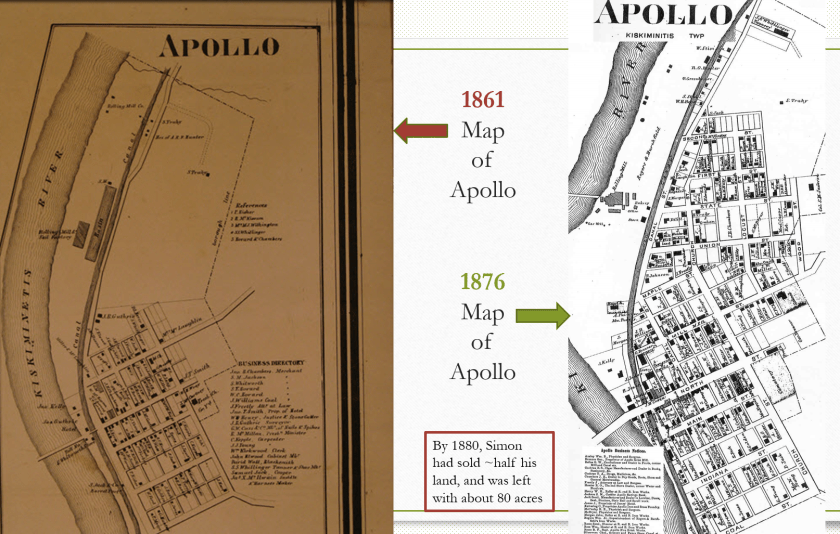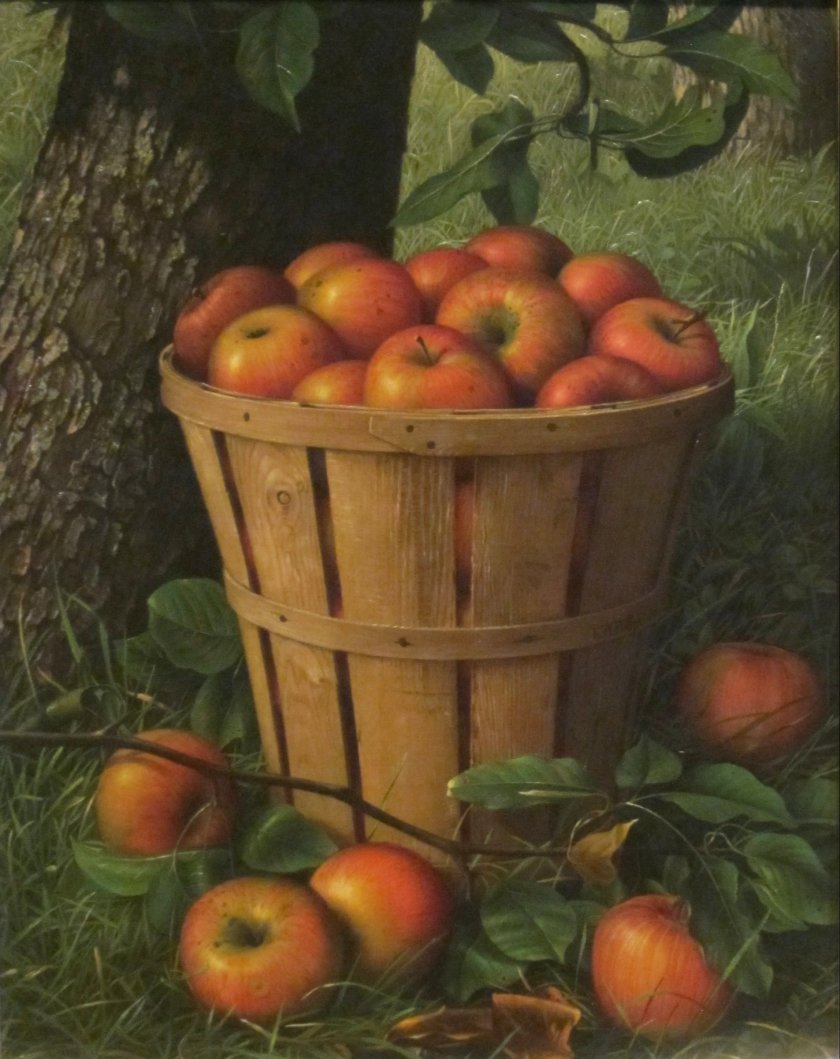If you happened to live in Apollo from 1859 to nearly the turn of the century, a thriving farm was practically a stone’s throw away in the same borough. It was almost like having a giant Guinta’s Fruit Market right in your back yard. Simon Truby’s 156-acre farmland (green in the map below) originally extended from below N. 6th Street in Apollo up to N. 16th Street in North Apollo borough. The farm was active from about 1844 to 1890. Although there were plenty of other local farms (Owens, McKinstry, Jackson, Hildebrand to name a few), Simon Truby’s was the only significant farm in Apollo borough in the 1800s.


In various years, the Truby farm was home to:
- 40 sheep that produced 100 pounds of wool;
- 35 chickens that laid 305 dozen eggs;
- an orchard with 200 apple trees & 40 peach trees;
- crops that included corn, oats, potatoes, and hay.
In 1850, Simon Truby’s farm produced 10 tons(!) of hay, which he likely used to help feed & bed his 6 milk cows, 4 horses, and 15 pigs. That same year, his farm also produced: 
- 400 pounds of butter
- 60 pounds of honey
- 300 bushels of oats
- 200 bushels of corn
- 100 bushels of buckwheat
- 20 bushels of potatoes
- and various unnamed market produce.
Though he’d purchased the property only 7 years earlier (in 1843), Simon seemed to get the farm up & running rather quickly.
Historic Farms & the U.S. Agricultural Census
How do we know these 170-year-old details about Simon Truby’s farm? We owe thanks to the benevolent digitizing efforts of the Pennsylvania Agricultural History Project, under the auspices of the Pennsylvania Historical & Museum Commission. The project’s website offers PDFs of the Agricultural Census records of individual farms in Pennsylvania for the years 1850, 1880, and 1927. If you have an ancestor who was a farmer in Pennsylvania during those years, you too can seek out a detailed summary of their farm records online …. as long as you can decipher the census-taker’s flowery handwriting and figure out which township the farm was in. County and township boundaries seemed to change a lot back in the 1800s. See the end of this blog post for more about searching for your own ancestors’ farms.
“If you have an ancestor who was a farmer in Pennsylvania in 1850, 1880, or 1927, you too can seek out a detailed summary of their farm records online.”
More about Simon Truby’s Farm in 1850
In 1850, Simon Truby’s farmland was partly in Warren (as Apollo was then known) and mostly in Kiski Twp. You can download the 2-page PDF that shows 1850 Agricultural Census data for Truby’s farm. The PDF also lists data for 40 other nearby farms, including farms owned by 3 McKinstrys (James, William, & Jackson), D. Risher, Philip & Michel Shutt, Samuel Jack, James Culp, Henry & John Clark, and John & Alexander Kerr.
| Download the 2-page PDF of the 1850 Agricultural Census records for Simon Truby and nearby farms in Kiski Twp: |  |

1880 Ag Census & Simon Truby’s Shrinking Farm

The maps below show how severely Simon Truby’s property shrank within Apollo borough over a 15-year time span, from 1861 to 1876. Simon’s land is the open space in the upper right portion of the map, and his brick farmhouse is the lonesome dot in the middle of the open space:

In the 1880 Ag Census—just 6 years before Simon’s death—his oldest son, Henry Hill Truby, was listed as the farm manager. The Census shows that the overall value of the Truby farm was $5,000 (comparable to more than $120,000 today). Truby hired farm laborers for 10 weeks a year and paid them wages totaling $40 (more than $1,000 in today’s dollars). He also did some sharecropping, renting out part of his land in exchange for a share of produce.
Find Your Own PA Ancestor’s Farm
Sad to say, the Ag census records aren’t easily searchable online—yet. Someday Ancestry.com or another organization may convert the handwritten Agricultural Census script into searchable documents. But for now, you’ll have to page through the documents yourself to find your ancestor. Happy to say, the Pennsylvania Agricultural History Project has simplified the search by categorizing the data by county and township.
Here are links to the original data on individual farms in Pennsylvania during different time periods:
- 1850 Federal Agricultural Census Manuscripts Select your ancestor’s county from the list, then the appropriate borough or township.
- 1880 Federal Agricultural Census Manuscripts Select your ancestor’s county from the list, then the appropriate borough or township.
- 1927 Triennial Agriculture Census Manuscripts Select your ancestor’s county from the list, then the appropriate borough or township.
Remember, in the 1800s, county and township boundaries were still changing, so it may take a little research to figure out where a historic farm was located.
If these links help uncover any cool info about your ancestor’s farm, please “Comment” on this blog post to let us know what you’ve learned.
Visit the Truby Farmhouse Apollo PA website and take a look around. Coming soon: Learn about Simon Truby’s brother Capt. Henry Truby, who had an almost identical 4-Over-4 brick farmhouse in Gilpin Twp., PA.

3 comments